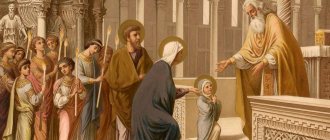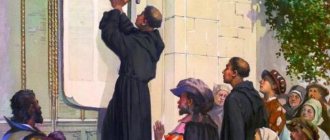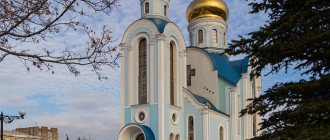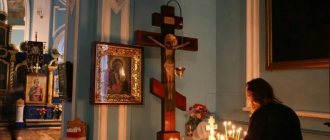PROTESTANTISM, one of the main (along with Orthodoxy and Catholicism) trends in Christianity, which arose in the 16th century. during the Reformation. The origin of the term dates back to the events of 1529, when at the Reichstag of the Holy Roman Empire, held in Germany. Speyer, it was proposed to cancel the decision of the previous Reichstag (1526, also in Speyer) on the right of princes and imperial cities to independently choose their religion on their territory before the convening of an all-German council. Supporters of the Reformation, who did not agree with this proposal and left the meeting, having previously drawn up the so-called. The Speyer protest (from the Latin protestatio - proclamation) began to be called Protestants. Subsequently, the term began to be applied to all adherents of the teachings that emerged as a result of the Reformation.
P., having arisen as a collection of various. movements, never represented, unlike Catholicism and Orthodoxy, a single whole. The largest movements of P. include Lutheranism, Calvinism, and Anglicanism (see Anglican Church), which are usually called “classical” P. They are associated with other independent principles. denominations that differ from each other in dogma, cult and organization: Baptists (see Baptistism), Mennonites, Methodists, Adventists (see Adventism), Pentecostals, Quakers, New Apostolic Church, etc. Jehovah's Witnesses, The Church of Jesus Christ of Latter-day Saints (Mormons ), the Christian Science Society and other denominations that are genetically related to Christianity, but in their ideological development have gone far beyond its framework (as well as Christianity in general), are usually classified as new religious movements.
Story
P. arose in the 16th century. in the West Europe in connection with the activities of M. Luther, W. Zwingli, J. Calvin, F. Melanchthon, M. Bucer, G. Bullinger, T. Cranmer and others. For P. in general, the statement about the need to return the Church to the faith of the first centuries is characteristic Christianity, which was distorted by later innovations of the Middle Ages. Catholicism.
"Luther publicly burns books of ecclesiastical law and a papal bull in Wittenberg on December 10, 1520." Engraving from the book “The History of the Holy Witnesses of the Lord” by L. Rabus. 1557.
M. Luther’s teaching on justification by faith, which became the cornerstone of philosophy, was embodied in the concept of three “only”: a person is saved by faith alone; he finds it only through the grace of God; The authority in matters of faith is only the Holy Scripture (Sola fide - “by faith alone”, Sola gratia - “by grace alone”, Sola Scriptura - “by Scripture alone”). Luther's special attitude to the Holy Scriptures (his translation of the Bible into German was a great contribution to culture), especially to the New Testament texts as to ch. authority, was the reason for calling his followers Evangelical. Christians (hereinafter referred to as Lutherans). The most important confessional documents of Lutheranism are Luther’s “Large Catechism” and “Small Catechism” (both 1529), the Augsburg Confession (1530), the Formula of Concord (1577), etc., collected in the Book of Concord, the publication of which in 1580 was supposed to indicate unity Lutheran Church.
Dr. An influential movement in the Reformation arose independently of Lutheranism in Switzerland and is associated with the doctrine of the Zurich priest. W. Zwingli, who agrees with the teachings of Luther in basic ideas (reliance on Holy Scripture, sharp criticism of scholastic theology, the principles of “justification by faith” and “universal priesthood”), but differs in a more rationalistic interpretation of the Eucharist and a more consistent criticism of church rites. From ser. 1530s the development of reformation ideas and their implementation in Switzerland are associated with the name of J. Calvin and his activities in Geneva. Ch. provisions of Calvin's teachings - interpretation of the concept of predestination and creation of a model of church and state. devices presented in Op. "Instruction in the Christian Faith" (1539). By the turn of the 16th–17th centuries. The followers of Zwingli and Calvin united into one movement - Calvinism. The most important religious documents of Calvinism are the Heidelberg Catechism (1563), the Canons of the Synod of Dordrecht (1618–19) and the Westminster Confession of Faith (1647).
"English King Edward VI and the Pope." An allegorical denunciation of the pope defeated by the English edition of the Bible. Painting by an unknown artist. National Portrait Gallery (London).
The third major direction of P. - Anglicanism - appeared during the reformation changes in the Church of England, begun on the initiative of King Henry VIII. English Parliament in 1529–1536 adopted a number of statutes that formed a national independent from Rome. Church, subordinate to the king since 1534. In 1536, the first doctrinal document of Anglicanism, the Ten Articles, was adopted, compiled by Archbishop. Canterbury Thomas Cranmer (1489–1556), ch. English ideologist Reformation. The doctrine of Anglicanism is reflected in the Book of Common Prayer (1549, 2nd ed. - 1552), the Book of Sermons (1548–53), and the Thirty-Nine Articles (1563). Carrying out the Reformation “from above”, the compromise nature of the reforms, the preservation of the church hierarchy with the apostolic succession of ordinations (this determines another name for the Anglican Church - the Episcopal Church) allow us to consider Anglicanism the most moderate movement of Protestantism.
From the 2nd half. 16th century Differences in Protestant theory and practice caused the formation of various. currents in the reform movement. Puritans appeared in England, advocating the cleansing of the Anglican Church from the Catholic heritage. traditions. In Calvinism, according to the principle of organizing communities, there was a division into Presbyterians (governed by an elective consistory headed by an elder) and Congregationalists (who proclaimed the complete autonomy of communities). Communities of continental European origin, predominantly French, Dutch and Swiss, began to be called Reformed (see Reformed). Reformed churches generally accept central government, and some of them, unlike Presbyterians and Congregationalists, have bishops. Spanish who polemicized with Calvin. theologian M. Servetus became one of the first preachers of Unitarianism - a doctrine that rejects the dogma of the Holy Trinity and the God-manhood of Jesus Christ (see Unitarians). In the 2nd half. 16th century Unitarianism spread to Poland, Lithuania, and Hungary in the 17th century. - in England, in the 19th century. - in USA.
The Reformation and P. found wide support among various people. layers of Europe society, the viability of the new religion. The movement was largely determined by the opportunity to express social protest with an appeal to biblical commandments. In Germany and Switzerland. In Zurich, Anabaptists began actively preaching about the establishment of social justice in society. Subjected to severe persecution from both Catholics and “classical” Protestants, the Anabaptists fled to Holland, England, the Czech Republic, Moravia (Hutterites), and later to the North. America. Some Anabaptists merged with the followers of the so-called. Moravian Church and in the 18th century. formed a community of Herrnhuters (see art. Moravian brothers). The most famous Anabaptist denomination is Mennoniteism, named after its founder, Netherlands. priest Menno Simons, whose followers chose emigration as a form of passive social protest. From the Mennonites in the 2nd half. 17th century The Amish separated. Influenced by the ideas of the Anabaptists and Mennonites in the middle. 17th century Quakerism appeared in England, distinguished by the doctrine of the “inner light,” unusual for the 17th century. social ethics (denial of social hierarchy, slavery, torture, death penalty, uncompromising pacifism, religious tolerance).
For Protestant theology of the 17th–18th centuries. Characteristic is the idea that the Church should consist only of consciously converted people who have experienced a personal encounter with Christ and active repentance. In “classical” P., the exponents of this idea were the Pietists (see Pietism) in Lutheranism and the Arminians (see Arminianism) in Calvinism. In con. 17th century from the Pietists to the department. The denomination was distinguished by a closed community of dunkers.
In 1609 in Holland from the English group. Puritans formed a community of followers of J. Smith - Baptists, who soon divided into “general” (followers of Smith) and “private” (followers of the English pastor G. Jacob, who founded a community in London in 1616). In 1639, Baptistism appeared in the North. America and is now the largest Protestant denomination in the United States.
Photo by D. V. Solovyov Presbyterian Church Tron Kirk in Edinburgh. 1636–47. Architect J. Milne.
Ch. feature of Methodism, which arose in Great Britain in the beginning. 18th century, is the doctrine of “sanctification”: a person’s free conversion to Christ (in the Arminian interpretation) takes place in two stages: first, God sanctifies a person with the righteousness of Christ (“justifying grace”), then gives him the gift of holiness (“sanctifying grace”). . Methodism quickly spread, primarily in the United States and in English-speaking countries, thanks to its unique forms of preaching - mass open-air services, the institute of itinerant preachers, home groups, as well as annual conferences of all ministers. The Church of the Nazarene (1895) and the Wesleyan Church (see Art. Methodists) emerged from Methodism, reproaching Methodism for excessive liberalism.
The Plymouth Brethren (Darbist) denomination, which appeared in Great Britain in the 1820s, adheres to the dispensationalist doctrine, according to which the history of mankind is divided into separate. periods, in each of them the characteristic law of God operates. In the 1840s. There was a split into “open” and “closed” Darbists.
Adventism began in the 1830s. in the USA based on the interpretation of biblical texts about the Second Coming of Jesus Christ and the possibility of its accurate calculation. In 1863, the organization of the largest movement in Adventism was created - the Seventh-day Adventist Church. During World War I, reformist Adventists emerged, dissatisfied with the Adventists' partial abandonment of pacifism. Seventh-day Adventists are distinguished by their denial of the immortality of the soul, the denial of heaven and hell, the reverence of the Sabbath as the seventh day of service to God, and the recognition of the restoration of the biblical gift of prophecy and vision through the founder of the church, E. White.
Will distinguish. a feature of the New Apostolic Church, which arose in the 2nd half. 19th century in the UK, community-based so-called. Irvingian, is the cult of the “apostles” - the leaders of the church, whose word has the same doctrinal authority as the Bible.
In the 19th century There has been a tendency towards blurring the boundaries of Protestant churches. In the English-speaking world, this was facilitated by revivalism, a movement that called Christians to repentance and personal conversion. The result was the emergence of the so-called. evangelicals and united churches. Evangelicals, who appeared in the United States in the 19th century, preach non-denominational personal conversion, “being born again” through the special action of God, changing the believer’s heart, faith in Christ’s sacrifice on the cross, and active missionary work. The conservative wing of the evangelicals created dispensationalism, the liberal wing created social evangelism (changing social reality in order to bring it closer to the Kingdom of God). T.n. neo-evangelicalism appeared in the 1940s, uniting those who criticized liberal evangelicals for moral relativism, and conservatives for their closeness and advocated the active preaching of modernity. means. Neo-evangelicalism has given rise to numerous groups in the United States. popular television programs (teleevangelism), etc. megachurches are church organizations in which there is a “center” (the main church led by a leader, developing a style of worship and preaching, benefits for Sunday schools and social work, etc.) and “branches” (numerous church communities located in direct and strict subordination to the “center”).
All R. 19 – beginning 20th centuries the so-called united churches as a result of the merger of different Protestant denominations - Lutherans, Anglicans, Reformed, Presbyterians, Methodists, Baptists, Quakers, etc. In most cases, the merger took place voluntarily, sometimes it was imposed by the state. power. The unifying basis of these churches is their historical involvement in the Reformation and doctrinal affinity. In con. 19th century the so-called free churches are Protestant communities that exist independently of the state. Protestant churches.
Development of P.'s theology in the 20th century. characterized by the development of the idea of the return of modernity. Mystical churches gifts of the ancient Church and the desire to adapt Christianity to non-European cultures. So, in the beginning 20th century From the Methodist group "Holiness Movement" Pentecostalism was formed, which is distinguished by its recognition of the exclusion. role in the Church of the Holy Spirit, the gift of glossolalia. In the 1960s–1970s. The Pentecostal movement received a new impetus for development due to representatives of Christian denominations using Pentecostalism. practices. Influenced by "contextual theology" and Pentecostalism in the 20th century. distinctive Asians emerged. and African churches.
Within the framework of Protestant theology, an ecumenical movement appeared in 1910 (see Ecumenism), which set as its task the unification of all Protestant churches. In 1948 in Amsterdam, on the basis of the inter-Protestant movements “Faith and Church Order”, “Life and Work” and “International Missionary Council”, the World Council of Churches (WCC) arose, which positions itself as a fellowship of Christian communities that is not a k.-l. church institute. The WCC and ecumenism as a movement cause conflicting assessments among Protestants: from acceptance to complete denial (for example, Adventists).
The total number of Protestants in the world St. 600 million people (according to the calculations of researchers who broadly interpret the affiliation of various denominations to P., about 800 million people). In 92 countries, Protestants are the largest denomination of Christianity in terms of the number of adherents; in 49 countries, Protestants make up the majority of the population.
Protestantism in Russia
The first foreign Protestants appeared in Russia already at the beginning of the Reformation: Lutherans - in the 1520s, Anglicans - under Ivan IV (1533-84), Calvinists - in the end. 16th century The permanent Protestant communities that formed in Moscow, Arkhangelsk, Vologda and other trading cities existed in isolation from the Russians. population. Protestants were allowed to freely profess their faith, but under pain of death they were forbidden to convert Russians to P. In the 17th–18th centuries. among ethnic Russians appeared so-called. spiritual Christianity - the Believers of Christ, the Doukhobors, the Molokans, whose doctrine was partly similar to the Protestant one (in particular, the denial of icons, the veneration of saints, the rejection of rituals, etc.). The government was hostile to sectarians; traditional the punishment was mass exile (for example, the Doukhobors and Molokans were deported to Transcaucasia in the 1st half of the 19th century).
Lutheran Church of St. George. Samara. 1863–64.
K con. 18 – beginning 19th centuries on the territory of Russia. empire, large Lutheran churches took shape in Finland, the Baltic states and small Calvinist communities in Poland, the Baltic states, and the West. Ukraine. After the decrees of the Emperor. Catherine II (1762, 1763) on attracting foreigners to Russia, in particular for the development of New Russia and the sparsely populated lands of the Volga region and the Urals, thousands of Germans - Lutherans and Mennonites - arrived. They were guaranteed freedom of religion. In the 1860s. through the efforts of the German Missionaries in Ukraine began to spread Baptistism, in the 1880s. – Adventism. In the 1870s. in St. Petersburg, as a result of the activities of Lord Redstock, a community of evangelical Christians appeared who, unlike the Baptists, adhered to Arminian views. At the same time, among the growing Communities of the New Apostolic Church arose from the Germans. In the beginning. 20th century in the north of Russia empire, the first Pentecostal communities appeared. In 1913, the Salvation Army began to actively work in Russia.
Sermon in the Moscow church of Evangelical Christians-Baptists. Photo 1941.
In the 1920s non-classical denominations P. were not pursued by the owls. authorities who considered the oppressed in Russia. empires of “sectarians” as allies in building a classless and just society. In con. 1920s - early 1930s persecution also spread to Protestants. Changing the attitude of the authorities towards religions. activities during Vel. Otech. war and after it allowed in 1944 to create the All-Union Council of Evangelical Christians-Baptists, in which, in addition to Baptists, Evangelical Christians, Mennonites and Pentecostals, and the All-Union Council of Seventh-day Adventists began to register. However, soon the communities of Pentecostals and “initiative” Baptists, dissatisfied with the strict control of the state over the lives of believers, began to leave the Council of Baptists and found themselves without registration and outside the law. In 1960, due to increased persecution of believers, the Adventist Union was deregistered until the end. 1980s Adventists led a semi-legal existence, although their activities were not officially prohibited.
In con. 1980s - early 1990s Those who disappeared in the Soviet Union were reborn. time Reformation, Methodism, Salvation Army, New Apostolic Church. In the 1990s. Legalized foreigners were actively working in Russia. missions of Protestants of all directions. Their activities led to a change in the composition of churches due to the influx of converts from traditionally non-Protestant families. The peoples of the North actively became involved in P.'s sphere of influence. the Caucasus and the Far North, creating new ethno-confessional communities. At the beginning 2010s lived in Russia approx. 1.5 million Protestants.
Literature
- Betzold F. von. History of the Reformation in Germany. St. Petersburg, 1980. T. 1-2
- Terentyev N.D. Lutheran confessional system according to the symbolic books of Lutheranism. Kazan, 1910
- Grundmann S. Der Lutherische Weltbund; Grundlagen, Herkunft, Aufbau. Cologne, 1957
- Swihart AK Luther and the Lutheran Church 1483-1960. NY, 1960
- Bergendoff C. The Church of the Lutheran Reformation. Saint Louis, 1967
- Bachmann ET, Bachmann MB The United Lutheran Church in America, 1918-1962. Minneapolis, 1997
- Chemnitz M. Key questions of theology. Minsk, 1999-2003. T. 1-2
- Siegbert B. The Foolishness of God. The place of reason in the theology of M. Luther. M., 2000
- Kolb R. Christian faith. M., 2000
- Petrenko V.I. Theology of Icons: A Protestant Perspective. St. Petersburg, 2000
- Todd M. Authority vested: a story of identity and change in the Lutheran Church-Missouri Synod. Grand Rapids, 2000
- Kurilo O.V. Lutherans in Russia: XVI-XX centuries. M., 2002
- Saarinen R. Faith and Holiness. Lutheran-Orthodox dialogue, 1959-2002. M.; Krasnodar, 2003 [1]
Creed
Pentecostal baptism. Italy.
In general, P. follows the basic principles. the provisions of the Nicene-Constantinopolitan Creed with the recognition of the Filioque; Most Protestants profess the doctrine of the Holy Trinity, but there are also Unitarians. While agreeing with general Protestant principles about the priority of Holy Scripture, about justification by faith, about the “universal priesthood,” about the abolition of the cult of saints and the Mother of God as intermediaries between God and people, different movements of P. adhere to the peculiarities of the doctrine that are characteristic only of them. For Calvinism, this is the doctrine of double predestination (some are initially destined for eternal salvation, others - for eternal destruction), for Baptistism - the independence of local communities, the separation of church and state, for Quakerism - the doctrine of the “inner light”, for Methodism - the idea of free will and the possibility of achieving holiness in earthly life, for Seventh-day Adventists - the veneration of Saturday as the seventh day and the concept of the body as a vessel of the spirit (hence the cult of healthy eating and lifestyle), for the New Apostolic Church - the cult of the modern. "apostles", the only heirs of the original Church, for Pentecostalism - the possibility of mysticism. communication with God through glossolalia.
From the Protestant principles of salvation follows a feature of Protestant ecclesiology - the priesthood of all believers. At the same time, in the Anglican Church, as well as in some Lutheran churches, the apostolic succession of ordinations is preserved. The church in Palestine is understood as a collection of communities of all believers in Christ (although some Protestant groups do not recognize other Protestant denominations as Christian). Anglicans, Lutherans, Calvinists and their followers recognize two sacraments - baptism and the Eucharist (communion, unlike Catholics, “under both types” - the Body and Blood of Christ); other church sacraments are understood only as rites. In the New Apostolic Church, three sacraments are recognized: baptism, communion and “sealing with the Holy Spirit” (performed only by the “apostle”), among the Herrnhuters, in addition to baptism and communion, confession is recognized. In all other Protestant denominations, baptism and communion are preserved as symbolic. Unitarians, Quakers, and the Salvation Army do not have rituals.
Most Protestants reject the Catholic doctrine of purgatory, but some influential Anglican and Methodist theologians speak of a post-mortem “purifying fire” that is not equivalent to hell. All Protestants agree that only faith saves a person, but they differ in their understanding of what role good works play in salvation.
Great importance is attached to work ethics in P. Luther and even more actively Calvin taught that any work activity can be pleasing to God. Hence the concept of “worldly calling”: God put each person in his place and entrusted him with a certain task, both in the family and in society, making him His steward; a person, working honestly, follows the path of salvation and glorifies God. Work becomes religion. value, frugality and abstinence in worldly life, “worldly asceticism” - one of the chapters. virtues.
Considering the relationship between society and the state, Luther assumed that a person should focus on personal righteousness, the Church should contribute to this, leaving “earthly” affairs to the state and not interfering in them, while “the manager should consider himself a servant, and not the master of the people.” Calvin proclaimed the need to combine personal moral discipline and the creation of a moral society. The Puritans in New England subsequently developed this idea, putting forward the principle of “covenant” - a covenant between God, man and society. Mennonites and Quakers, partly Adventists, adhere to pacifism and a ban on military service.
Several stand out. historical periods and directions of development of theology P. Classic. Protestant theology (orthodoxy) developed in the period from Luther, Melanchthon, Zwingli, Calvin to J. Edwards (1703–58). Within its framework, general Protestant principles were developed and developed and the provisions of Protestant ethics were formulated.
Liberal Protestant theology (F. Schleiermacher, E. Troeltsch, A. von Harnack), which appeared in the end. 18 – beginning 19th centuries, shifted the emphasis from the supernatural aspects of Christian doctrine to the ethical. and social and questioned the provisions of Christian dogma (miracles of Christ, Resurrection of Christ, etc.). The Bible began to be seen not as a Divine revelation, but as a product of religions. creativity, limited by history and culture. Liberal theology was accompanied by the rapid development of biblical studies (Harnack, A. Ritschl, etc.).
Fundamentalist Protestant theology arose among evangelicals (late 19th century), and received its name from the series of pamphlets “The fundamentals: a testimony to the truth” published in 1910–15. Opposing liberal theology, she insisted on the absolute reliability of general Christian dogmas and a literalist reading of the Bible. Fundamentalist Protestants tend to actively participate in politics (usually professing extreme right-wing views) and influence public opinion.
As a general designation for a number of areas of Reformed and Lutheran theology, including dialectical theology, theology of crisis, theology of paradox, theology of the word of God, etc., which arose in the 1920s and 30s, seeking to respond to the challenges of Christian liberalism and fundamentalism, the term neo-orthodoxy is used. Dialectical theology (father K. Barth), which arose under the influence of the ideas of S. Kierkegaard, insists on the contradiction between faith and rationality, on the absolute unknowability and “ahistoricality” of God. Prominent representatives of neo-orthodoxy - R. Niebuhr, R. Bultmann, E. Brunner, P. Tillich and others.
Radical or "new" theology arose after World War II. One of its founders was the Lutheran pastor D. Bonhoeffer. He distinguished between faith as a decision to go towards a personal God and religion as the objectification of the mystical. experience in cult practices. Religion becomes unnecessary for a person who is increasingly less dependent on collective practices and strives for independence. decisions, i.e., becoming an “adult”. The faith that a person acquires, and the Church that preserves this faith, must serve people and their needs. Christianity must overcome external “religiosity” and become “non-religious” and personal. Baptist theologian H. Cox in the book. “The Worldly City” (1965) spoke about the justification of secularization as a natural act of “growing up” of humanity and the need to change the forms and methods of human communication with God.
The ideas of D. Bonhoeffer and H. Cox inspired many. Protestant theologians to look for the path of faith in the secular world from the position of “religious Christianity” and gave rise to many so-called. genitive theologies (“theology of the death of God”, “theology of hope”, etc.). All of them, in one way or another, relate not only to God, but also to various aspects of human life, which reflects their main postulate: the word about God in modern times. world – this is also a word about a person. God, according to these theories, does not reveal Himself directly in modern times. world, He is not in the consciousness of modern people. secular people; the old Christian metaphysics turned out to be unsuitable, the usual image of God was destroyed. Man and his problems are where modernity lies. theologians must seek the real, non-metaphysical God. “Theology of the genitive case” is chosen as the subject of consideration. aspects: complete moral sovereignty of man in a godless world (“theology of the death of God”, “theology of the death of theology”); interpersonal relationships and love for people as the most important principle of life (“theology of crisis”); shifting the emphasis from personal to social salvation - social theology (“political theology”, “theology of hope”, “black theology”, etc.). Contextual theology (Asian, African and Judeo-Christian churches) not only takes into account national. specificity in worship and preaching, but also combines the slogans of the national with theology. revival, suggests ways to solve the national problems.
Protestantism differs from Orthodoxy
| Orthodoxy | Protestantism | |
| Organization | This is a group of churches that have the same standards (morals/behaviors) and faith | It arose as a protest, as a movement against Roman Catholicism in the 16th century. These are many different movements; this religion has never been united. Currents differ from each other in sacred scriptures, rules, organization, cult |
| Holy Spirit | The Orthodox preach about the procession of the Holy Spirit only “from the Father” | While Protestants preach the "filioque" - the Catholic doctrine that the Holy Spirit proceeds "from the Father and the Son" |
| Judgment Day/Judgment | Orthodox believe that there will be a Day of Judgment, on which God will be merciful, just and wise | For some, to save the soul you need to believe in Christ, for others, the salvation of everyone, just as condemnation depends on Divine predestination (there are significant differences in its understanding; opinions on this issue in the main currents of Protestantism vary greatly) |
| Hierarchy | In Orthodoxy there is a holy order and a three-part hierarchy - bishop, presbyter, deacon | There is no special distribution of titles |
| Prayers of remembrance | There are prayers to remember the dead | They do not remember the dead in prayers because they are confident in their salvation |
| Bread and Wine | In the Sacrament of the Eucharist it is believed that bread and wine are transformed into the real Body and Blood of Christ | In those movements where there is Communion, bread and wine are considered just a reminder of the mission of Christ |
| Infant Baptism | Baptism of infants according to the faith of their parents | It is not common practice to baptize infants |
| Monasticism | Monasticism plays a big role | Monasticism often does not exist |
| Female priesthood | There is no female priesthood | The female priesthood exists |
| Icons | Veneration of holy icons | Denial of veneration of holy icons, since they consider icons to be idols |
| The Saints | There is a Heavenly Church (prayers to the saints) | For many, there is no Heavenly Church; prayers are addressed only to God |
| Same-sex relationships/marriage | Same-sex intimate relationships are considered a sin, marriage is impossible | Over time, there are more and more communities where both the first and the second are possible. |
| Baptism and Salvation | Baptism does not guarantee salvation | All sins are forgiven to the baptized and salvation is guaranteed. |
| Guardian angel | There is a guardian angel | No guardian angel |
Organizational principles
Ch. The structural unit in P. is the community, which is governed by a pastor and a congregation of believers. Church ministers are considered simple delegates of the community of believers; all believers are holders of the priesthood. At the same time, in a number of churches there is a church hierarchy with direct subordination of communities; Anglicanism retains the episcopate. The Salvation Army, Seventh-day Adventism and the New Apostolic Church share the same leadership. center, the remaining denominations are organized into independent unions and associations with great community autonomy. Occupying an intermediate position is the Methodist Church, consisting of autonomous churches but governed by an annual bicameral (clergy and laity) conference.
To the beginning 21st century pl. Protestant churches have recognized the female priesthood: the Anglican Church, a number of Lutheran, Methodist and Pentecostal churches. charismatic churches sense, some Presbyterian and Baptist associations. Among Seventh-day Adventists, a woman can be a deaconess. Mn. Protestants pay church tithes.
Liturgical practice
Worship usually consists of the singing of hymns, congregational prayer, reading of Scripture, and a sermon. The style of worship depends both on the tradition of the confession and on the attitudes of the department. communities
Lutherans, Anglicans, Presbyterians, Mennonites, Methodists recognize different. forms of water baptism: in practice, pouring is more often used, methodologists use sprinkling; in Baptistism, Evangelical Christianity, Adventism, Pentecostalism, and the New Apostolic Church, baptism is performed exclusively by complete immersion. Anglicans, Lutherans, Presbyterians, Congregationalists, Reformed, Methodists, the New Apostolic Church practice baptism of children, Baptists, Adventists, Pentecostals recognize baptism only for adults (usually at 12–18 years of age, among the Hutterites at 20–30 years of age). Children are usually blessed by the pastor at birth, attend worship services, but are not considered members of the Church. In some Protestant denominations, confirmation exists as a rite (in the Anglican Church it is performed by a bishop).
Among the Amish and Dunkers, as well as in a number of Baptist, Adventist and Pentecostal churches. Before the breaking of bread, communities perform the ritual of washing their feet as an element of the Last Supper. Funeral rites are accepted in most Protestant denominations (see Art. Burial), but there are no prayers for the deceased.
Protestants, with the exception of Quakers and Seventh-day Adventists, celebrate the Nativity of Christ, the Epiphany, Easter and Pentecost. The Anglicans have preserved almost all Catholic holidays. Churches, including days of veneration of saints, among Lutherans - 1st Sunday of Advent, Maundy Thursday, Good Friday, All Saints' Day, All Souls' Day. Baptists celebrate the Feast of Harvest (September–October).
Protestant denominations
Scheme of 1/3 Protestant movements and denominations belonging to them
Protestantism evolved from the Roman Catholic Church, which in turn developed from the early Christian Church. Further history gave us Lutheranism and Anglicanism.
Anglicanism also developed into such directions as: the Episcopal Church and the Evangelical Lutheran Church (also derived from Lutheranism).
Scheme 2/3 of Protestant movements and denominations belonging to them
From the development of Anglicanism already came Congregationalism, Methodism (which gave us the Salvation Army, the United Methodist Church, the Holiness movement and Pentecostalism).
Scheme 3/3 of Protestant movements and denominations belonging to them
Pure Protestantism has already given us Quakerism, Baptistism (which developed into the Southern Baptist Convention, Adventism and the Seventh-day Adventists), Anabaptism (which gave us Mennonite and Amish), and Reformedism (which developed into Presbyterianism and the Church of Scotland).
Architecture and fine arts
Library of Congress "Glass Church" in Rancho Palos Verdes, California. 1949–51. Architect L. Wright.
The founders of P. had different attitudes towards the possibility of using art in the Church and religions. life. M. Luther believed it was possible to use images of edification. and teach. character, illustrating the Holy Scriptures, but did not consider their presence mandatory and did not assign them a significant role. J. Calvin considered it impossible to depict God because of the danger of idolatry, reserving the right to transfer historical history to the claim. events. A. Karlstadt and W. Zwingli were fierce iconoclasts; during the 16th century. iconoclasm was accompanied by the destruction of works of church art (in Germany in the 1520s, in England from 1536, in Scotland in 1559, in France in 1560–62, in the Netherlands in 1566–67, etc.).
“Contrasting the righteous church with the unrighteous church.” Artist L. Cranach the Younger. Woodcut. OK. 1550.
Under the influence of Protestant theology, the iconography of some traditions changed. scenes: “The Last Judgment” is depicted without the interceding Mother of God, “Behold the Man” - without the wounds of Christ. The “Lamentation” scene lost popularity; the scenes of “Christ and the Harlot”, “Christ and the Samaritan Woman”, “Job and Elihu” came to the fore, which, together with the new composition “Law and Grace” attributed to L. Cranach the Elder (1529, Friedenstein Castle, Gotha, Thuringia) illustrated the principle of salvation by faith. Cranach created many portraits of Luther, illustrated the edition of the Bible in his translation; Cranach's workshop became the center for the printing of propaganda engravings that clearly explained the differences between Lutheran ideas and Roman Catholic ones [the series “The Passion of Christ and Antichrist” by Cranach the Elder (1521), which compares the life of Christ and the life of the Pope; engraving “The main differences between the true religion of Christ and the false idolatrous teaching of the Antichrist” by L. Cranach the Younger (c. 1547), etc.]. In Lutheran churches, it was allowed to have an altar image with scenes of the Last Supper or the Crucifixion, which preserved tradition. a type of polyptych, but using new iconography, often including the figures of the Reformation themselves.
Photo by Balthazar Korab Northern Christian Church (Disciples of Christ) in Columbus, Indiana. 1964. Architect E. Saarinen.
For a long time, Protestant services were held in previously built Catholic churches. temples Own P.'s church architecture arose only in the end. 17th century and developed on the basis of traditions. types (centric and basilical), relying in each region on local architecture. traditions, also following the stylistic trends of the era. Basic The functional requirement of church space became spaciousness and convenience of preaching, ch. elements in the interior - preacher. pulpit, baptismal font (in some directions the parish is placed near the altar), altar and organ. In Protestant countries, the Church has lost its role as head. will depict the customer of the works. art, which served as an incentive for the development of secular art.









